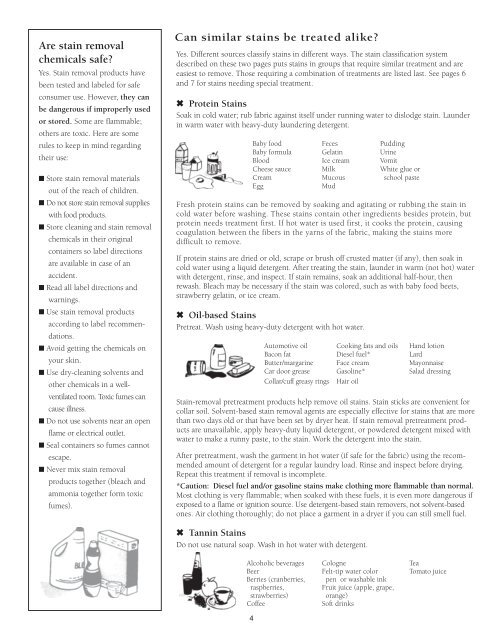n Easy Stain Removal - Orange County Extension Education Center
n Easy Stain Removal - Orange County Extension Education Center
n Easy Stain Removal - Orange County Extension Education Center
You also want an ePaper? Increase the reach of your titles
YUMPU automatically turns print PDFs into web optimized ePapers that Google loves.
Are stain removal<br />
chemicals safe?<br />
Yes. <strong>Stain</strong> removal products have<br />
been tested and labeled for safe<br />
consumer use. However, they can<br />
be dangerous if improperly used<br />
or stored. Some are flammable;<br />
others are toxic. Here are some<br />
rules to keep in mind regarding<br />
their use:<br />
■ Store stain removal materials<br />
out of the reach of children.<br />
■ Do not store stain removal supplies<br />
with food products.<br />
■ Store cleaning and stain removal<br />
chemicals in their original<br />
containers so label directions<br />
are available in case of an<br />
accident.<br />
■ Read all label directions and<br />
warnings.<br />
■ Use stain removal products<br />
according to label recommendations.<br />
■ Avoid getting the chemicals on<br />
your skin.<br />
■ Use dry-cleaning solvents and<br />
other chemicals in a wellventilated<br />
room. Toxic fumes can<br />
cause illness.<br />
■␣ Do not use solvents near an open<br />
flame or electrical outlet.<br />
■ Seal containers so fumes cannot<br />
escape.<br />
■ Never mix stain removal<br />
products together (bleach and<br />
ammonia together form toxic<br />
fumes).<br />
Can similar stains be treated alike?<br />
Yes. Different sources classify stains in different ways. The stain classification system<br />
described on these two pages puts stains in groups that require similar treatment and are<br />
easiest to remove. Those requiring a combination of treatments are listed last. See pages 6<br />
and 7 for stains needing special treatment.<br />
✖ Protein <strong>Stain</strong>s<br />
Soak in cold water; rub fabric against itself under running water to dislodge stain. Launder<br />
in warm water with heavy-duty laundering detergent.<br />
Baby food Feces Pudding<br />
Baby formula Gelatin Urine<br />
Blood Ice cream Vomit<br />
Cheese sauce Milk White glue or<br />
Cream Mucous school paste<br />
Egg Mud<br />
Fresh protein stains can be removed by soaking and agitating or rubbing the stain in<br />
cold water before washing. These stains contain other ingredients besides protein, but<br />
protein needs treatment first. If hot water is used first, it cooks the protein, causing<br />
coagulation between the fibers in the yarns of the fabric, making the stains more<br />
difficult to remove.<br />
If protein stains are dried or old, scrape or brush off crusted matter (if any), then soak in<br />
cold water using a liquid detergent. After treating the stain, launder in warm (not hot) water<br />
with detergent, rinse, and inspect. If stain remains, soak an additional half-hour, then<br />
rewash. Bleach may be necessary if the stain was colored, such as with baby food beets,<br />
strawberry gelatin, or ice cream.<br />
✖ Oil-based <strong>Stain</strong>s<br />
Pretreat. Wash using heavy-duty detergent with hot water.<br />
✖ Tannin <strong>Stain</strong>s<br />
Do not use natural soap. Wash in hot water with detergent.<br />
Alcoholic beverages Cologne Tea<br />
Beer Felt-tip water color Tomato juice<br />
Berries (cranberries, pen or washable ink<br />
raspberries, Fruit juice (apple, grape,<br />
strawberries) orange)<br />
Coffee Soft drinks<br />
4<br />
Automotive oil Cooking fats and oils Hand lotion<br />
Bacon fat Diesel fuel* Lard<br />
Butter/margarine Face cream Mayonnaise<br />
Car door grease Gasoline* Salad dressing<br />
Collar/cuff greasy rings Hair oil<br />
<strong>Stain</strong>-removal pretreatment products help remove oil stains. <strong>Stain</strong> sticks are convenient for<br />
collar soil. Solvent-based stain removal agents are especially effective for stains that are more<br />
than two days old or that have been set by dryer heat. If stain removal pretreatment products<br />
are unavailable, apply heavy-duty liquid detergent, or powdered detergent mixed with<br />
water to make a runny paste, to the stain. Work the detergent into the stain.<br />
After pretreatment, wash the garment in hot water (if safe for the fabric) using the recommended<br />
amount of detergent for a regular laundry load. Rinse and inspect before drying.<br />
Repeat this treatment if removal is incomplete.<br />
*Caution: Diesel fuel and/or gasoline stains make clothing more flammable than normal.<br />
Most clothing is very flammable; when soaked with these fuels, it is even more dangerous if<br />
exposed to a flame or ignition source. Use detergent-based stain removers, not solvent-based<br />
ones. Air clothing thoroughly; do not place a garment in a dryer if you can still smell fuel.
















